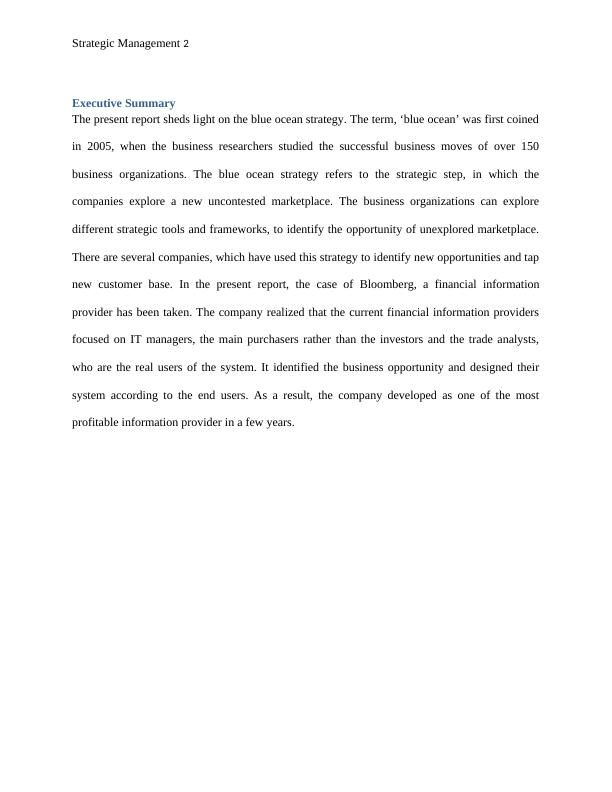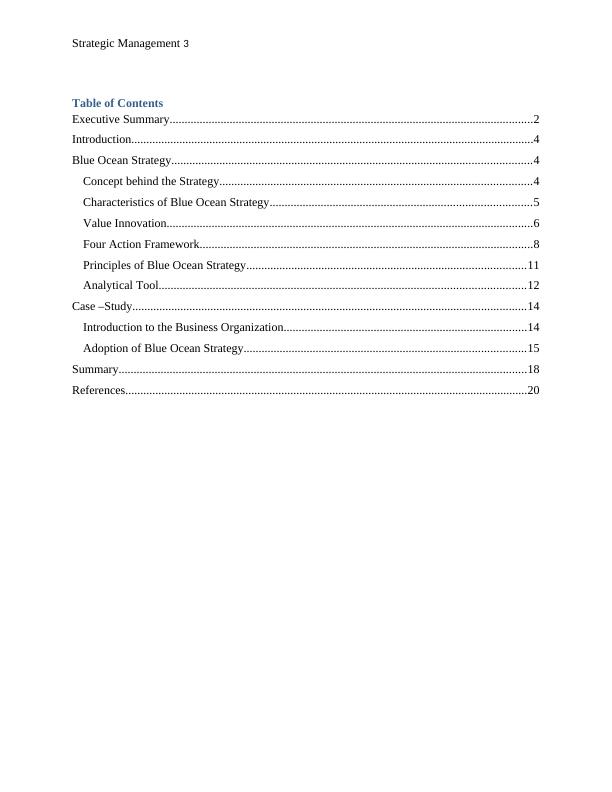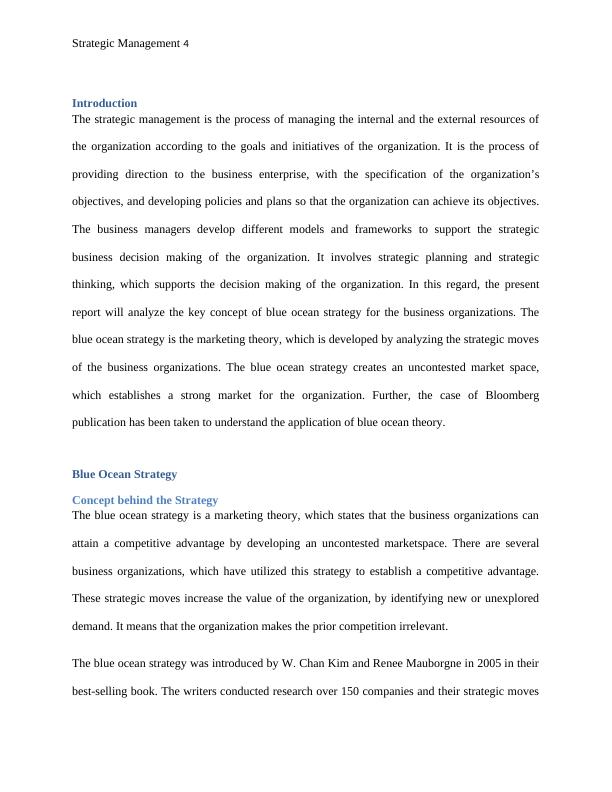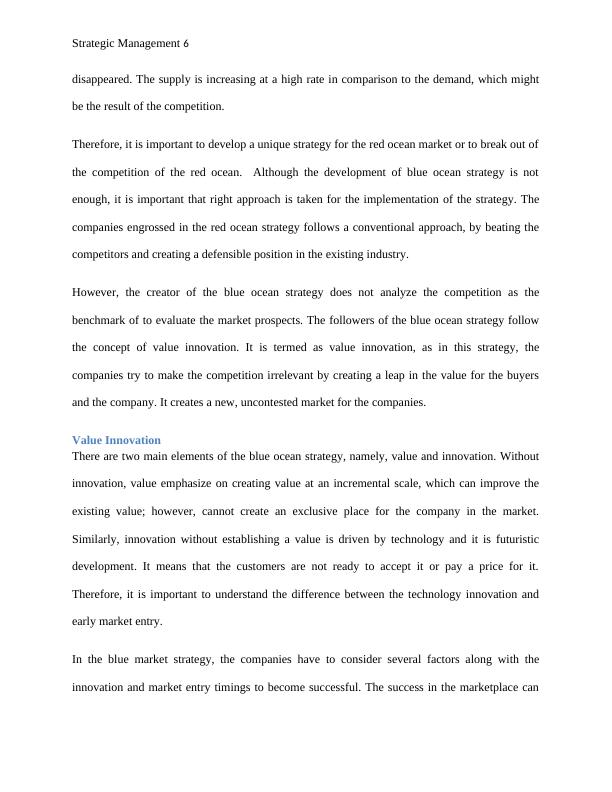Blue Ocean Strategy: A Unique Approach to Strategic Management
22 Pages5596 Words131 Views
Added on 2023-06-14
About This Document
This report discusses the blue ocean strategy, a unique approach to strategic management that creates an uncontested market space for organizations. It explores the principles, characteristics, and analytical tools of the strategy with a case study of Bloomberg. The report also discusses the value innovation and the four action framework of the strategy. Subject: Strategic Management, Course Code: N/A, Course Name: N/A, College/University: N/A
Blue Ocean Strategy: A Unique Approach to Strategic Management
Added on 2023-06-14
ShareRelated Documents
Running Head: STRATEGIC MANAGEMENT 1
Strategic Management
Strategic Management

Strategic Management 2
Executive Summary
The present report sheds light on the blue ocean strategy. The term, ‘blue ocean’ was first coined
in 2005, when the business researchers studied the successful business moves of over 150
business organizations. The blue ocean strategy refers to the strategic step, in which the
companies explore a new uncontested marketplace. The business organizations can explore
different strategic tools and frameworks, to identify the opportunity of unexplored marketplace.
There are several companies, which have used this strategy to identify new opportunities and tap
new customer base. In the present report, the case of Bloomberg, a financial information
provider has been taken. The company realized that the current financial information providers
focused on IT managers, the main purchasers rather than the investors and the trade analysts,
who are the real users of the system. It identified the business opportunity and designed their
system according to the end users. As a result, the company developed as one of the most
profitable information provider in a few years.
Executive Summary
The present report sheds light on the blue ocean strategy. The term, ‘blue ocean’ was first coined
in 2005, when the business researchers studied the successful business moves of over 150
business organizations. The blue ocean strategy refers to the strategic step, in which the
companies explore a new uncontested marketplace. The business organizations can explore
different strategic tools and frameworks, to identify the opportunity of unexplored marketplace.
There are several companies, which have used this strategy to identify new opportunities and tap
new customer base. In the present report, the case of Bloomberg, a financial information
provider has been taken. The company realized that the current financial information providers
focused on IT managers, the main purchasers rather than the investors and the trade analysts,
who are the real users of the system. It identified the business opportunity and designed their
system according to the end users. As a result, the company developed as one of the most
profitable information provider in a few years.

Strategic Management 3
Table of Contents
Executive Summary.........................................................................................................................2
Introduction......................................................................................................................................4
Blue Ocean Strategy........................................................................................................................4
Concept behind the Strategy........................................................................................................4
Characteristics of Blue Ocean Strategy.......................................................................................5
Value Innovation..........................................................................................................................6
Four Action Framework...............................................................................................................8
Principles of Blue Ocean Strategy.............................................................................................11
Analytical Tool..........................................................................................................................12
Case –Study...................................................................................................................................14
Introduction to the Business Organization.................................................................................14
Adoption of Blue Ocean Strategy..............................................................................................15
Summary........................................................................................................................................18
References......................................................................................................................................20
Table of Contents
Executive Summary.........................................................................................................................2
Introduction......................................................................................................................................4
Blue Ocean Strategy........................................................................................................................4
Concept behind the Strategy........................................................................................................4
Characteristics of Blue Ocean Strategy.......................................................................................5
Value Innovation..........................................................................................................................6
Four Action Framework...............................................................................................................8
Principles of Blue Ocean Strategy.............................................................................................11
Analytical Tool..........................................................................................................................12
Case –Study...................................................................................................................................14
Introduction to the Business Organization.................................................................................14
Adoption of Blue Ocean Strategy..............................................................................................15
Summary........................................................................................................................................18
References......................................................................................................................................20

Strategic Management 4
Introduction
The strategic management is the process of managing the internal and the external resources of
the organization according to the goals and initiatives of the organization. It is the process of
providing direction to the business enterprise, with the specification of the organization’s
objectives, and developing policies and plans so that the organization can achieve its objectives.
The business managers develop different models and frameworks to support the strategic
business decision making of the organization. It involves strategic planning and strategic
thinking, which supports the decision making of the organization. In this regard, the present
report will analyze the key concept of blue ocean strategy for the business organizations. The
blue ocean strategy is the marketing theory, which is developed by analyzing the strategic moves
of the business organizations. The blue ocean strategy creates an uncontested market space,
which establishes a strong market for the organization. Further, the case of Bloomberg
publication has been taken to understand the application of blue ocean theory.
Blue Ocean Strategy
Concept behind the Strategy
The blue ocean strategy is a marketing theory, which states that the business organizations can
attain a competitive advantage by developing an uncontested marketspace. There are several
business organizations, which have utilized this strategy to establish a competitive advantage.
These strategic moves increase the value of the organization, by identifying new or unexplored
demand. It means that the organization makes the prior competition irrelevant.
The blue ocean strategy was introduced by W. Chan Kim and Renee Mauborgne in 2005 in their
best-selling book. The writers conducted research over 150 companies and their strategic moves
Introduction
The strategic management is the process of managing the internal and the external resources of
the organization according to the goals and initiatives of the organization. It is the process of
providing direction to the business enterprise, with the specification of the organization’s
objectives, and developing policies and plans so that the organization can achieve its objectives.
The business managers develop different models and frameworks to support the strategic
business decision making of the organization. It involves strategic planning and strategic
thinking, which supports the decision making of the organization. In this regard, the present
report will analyze the key concept of blue ocean strategy for the business organizations. The
blue ocean strategy is the marketing theory, which is developed by analyzing the strategic moves
of the business organizations. The blue ocean strategy creates an uncontested market space,
which establishes a strong market for the organization. Further, the case of Bloomberg
publication has been taken to understand the application of blue ocean theory.
Blue Ocean Strategy
Concept behind the Strategy
The blue ocean strategy is a marketing theory, which states that the business organizations can
attain a competitive advantage by developing an uncontested marketspace. There are several
business organizations, which have utilized this strategy to establish a competitive advantage.
These strategic moves increase the value of the organization, by identifying new or unexplored
demand. It means that the organization makes the prior competition irrelevant.
The blue ocean strategy was introduced by W. Chan Kim and Renee Mauborgne in 2005 in their
best-selling book. The writers conducted research over 150 companies and their strategic moves

Strategic Management 5
to propose the strategy, which can create a new, uncontested market for the organization. The
book asserts that these strategic moves can enhance the value of the organization. The companies
can create success by creating “Blue Ocean” of uncontested marketplace, in contrast to the “red
ocean”, where different companies fight for dominance.
Characteristics of Blue Ocean Strategy
The blue ocean is defined by the untapped marketspace, novel demand and opportunity of high
growth. Several times, the companies create Blue Ocean beyond the existing industry
boundaries, which establish unexplored marketspace. Blue ocean strategy is used to new profit
and growth strategy. However, there is little research over the blue ocean strategy and it is
considered as a wishful thinking, which is too risky to pursue as a strategy. Therefore, most of
the business organizations focus on the red ocean strategy. The scholars have explored different
options such as cost leadership or product differentiation to lead in the red ocean market.
However, there is lack of focus on the blue ocean strategy. The business launch in both blue and
red can require investment; however, the performance benefits of the blue ocean strategy are
evident.
There are several forces, which motivates the companies to create blue ocean market for them.
There has been a substantial technological development, which has increased the industrial
productivity, and allowed the suppliers to product an array of objects and services. However, this
phenomenon is resulting in higher supply in comparison to the demand. There is a strong trend
towards the globalization, in which the trade barriers between the products and services have
reduced and the information regarding the product and the pricing is instantly and globally
available. With the advance in the knowledge, the monopoly has reduced and niche market has
to propose the strategy, which can create a new, uncontested market for the organization. The
book asserts that these strategic moves can enhance the value of the organization. The companies
can create success by creating “Blue Ocean” of uncontested marketplace, in contrast to the “red
ocean”, where different companies fight for dominance.
Characteristics of Blue Ocean Strategy
The blue ocean is defined by the untapped marketspace, novel demand and opportunity of high
growth. Several times, the companies create Blue Ocean beyond the existing industry
boundaries, which establish unexplored marketspace. Blue ocean strategy is used to new profit
and growth strategy. However, there is little research over the blue ocean strategy and it is
considered as a wishful thinking, which is too risky to pursue as a strategy. Therefore, most of
the business organizations focus on the red ocean strategy. The scholars have explored different
options such as cost leadership or product differentiation to lead in the red ocean market.
However, there is lack of focus on the blue ocean strategy. The business launch in both blue and
red can require investment; however, the performance benefits of the blue ocean strategy are
evident.
There are several forces, which motivates the companies to create blue ocean market for them.
There has been a substantial technological development, which has increased the industrial
productivity, and allowed the suppliers to product an array of objects and services. However, this
phenomenon is resulting in higher supply in comparison to the demand. There is a strong trend
towards the globalization, in which the trade barriers between the products and services have
reduced and the information regarding the product and the pricing is instantly and globally
available. With the advance in the knowledge, the monopoly has reduced and niche market has

Strategic Management 6
disappeared. The supply is increasing at a high rate in comparison to the demand, which might
be the result of the competition.
Therefore, it is important to develop a unique strategy for the red ocean market or to break out of
the competition of the red ocean. Although the development of blue ocean strategy is not
enough, it is important that right approach is taken for the implementation of the strategy. The
companies engrossed in the red ocean strategy follows a conventional approach, by beating the
competitors and creating a defensible position in the existing industry.
However, the creator of the blue ocean strategy does not analyze the competition as the
benchmark of to evaluate the market prospects. The followers of the blue ocean strategy follow
the concept of value innovation. It is termed as value innovation, as in this strategy, the
companies try to make the competition irrelevant by creating a leap in the value for the buyers
and the company. It creates a new, uncontested market for the companies.
Value Innovation
There are two main elements of the blue ocean strategy, namely, value and innovation. Without
innovation, value emphasize on creating value at an incremental scale, which can improve the
existing value; however, cannot create an exclusive place for the company in the market.
Similarly, innovation without establishing a value is driven by technology and it is futuristic
development. It means that the customers are not ready to accept it or pay a price for it.
Therefore, it is important to understand the difference between the technology innovation and
early market entry.
In the blue market strategy, the companies have to consider several factors along with the
innovation and market entry timings to become successful. The success in the marketplace can
disappeared. The supply is increasing at a high rate in comparison to the demand, which might
be the result of the competition.
Therefore, it is important to develop a unique strategy for the red ocean market or to break out of
the competition of the red ocean. Although the development of blue ocean strategy is not
enough, it is important that right approach is taken for the implementation of the strategy. The
companies engrossed in the red ocean strategy follows a conventional approach, by beating the
competitors and creating a defensible position in the existing industry.
However, the creator of the blue ocean strategy does not analyze the competition as the
benchmark of to evaluate the market prospects. The followers of the blue ocean strategy follow
the concept of value innovation. It is termed as value innovation, as in this strategy, the
companies try to make the competition irrelevant by creating a leap in the value for the buyers
and the company. It creates a new, uncontested market for the companies.
Value Innovation
There are two main elements of the blue ocean strategy, namely, value and innovation. Without
innovation, value emphasize on creating value at an incremental scale, which can improve the
existing value; however, cannot create an exclusive place for the company in the market.
Similarly, innovation without establishing a value is driven by technology and it is futuristic
development. It means that the customers are not ready to accept it or pay a price for it.
Therefore, it is important to understand the difference between the technology innovation and
early market entry.
In the blue market strategy, the companies have to consider several factors along with the
innovation and market entry timings to become successful. The success in the marketplace can

End of preview
Want to access all the pages? Upload your documents or become a member.
Related Documents
Managing Innovation: Blue Ocean Strategy and its Applicationlg...
|19
|5149
|59
Managing Innovation: Blue Ocean Strategylg...
|14
|3648
|94
Managing Innovation Reportlg...
|12
|3366
|59
Blue Ocean Strategy: Innovation for Market Successlg...
|15
|3823
|81
Managing Innovation Assessmentlg...
|13
|3643
|135
Blue Ocean Strategy, Innovator Dilemma, Good Management, Lean Start-uplg...
|5
|2133
|217
